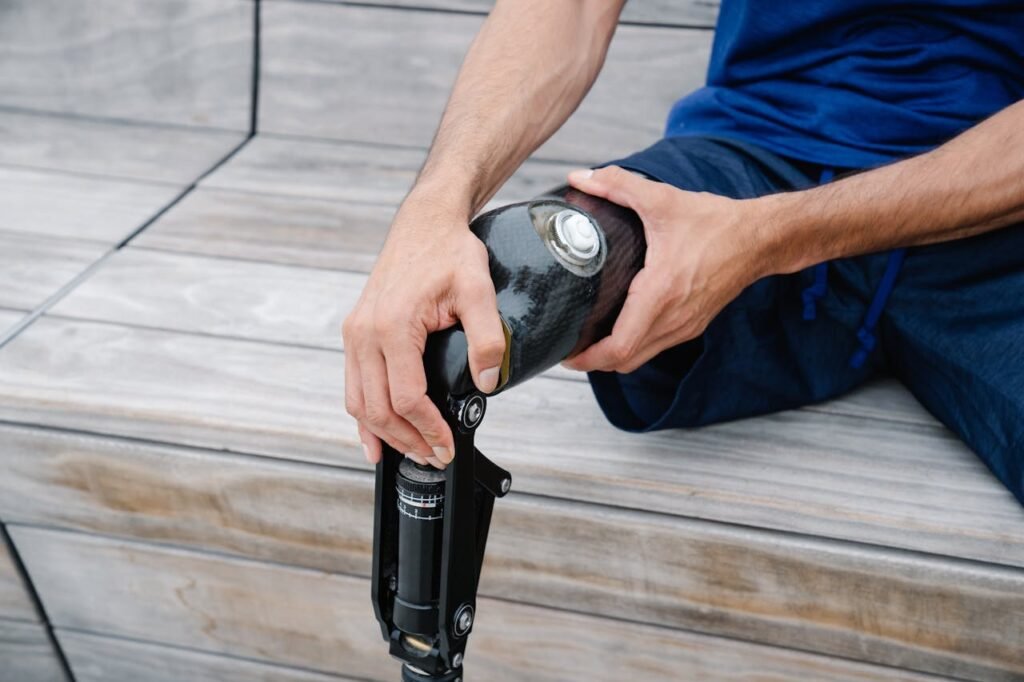Prosthetics are life-changing devices that restore independence and mobility, but like any complex tool, they require regular care and maintenance to perform at their best. While daily cleaning and routine checks are essential for keeping your prosthetic in good condition, professional expertise plays a vital role in addressing wear, alignment, and long-term functionality.
Knowing how often to visit your prosthetist for maintenance is key to ensuring the longevity of your prosthetic and maintaining your comfort and mobility. This article explores the factors that influence the frequency of prosthetist visits, what to expect during maintenance appointments, and how to stay proactive in managing your prosthetic care.
Understanding the Importance of Regular Prosthetist Visits
Seeing your prosthetist regularly is not just about fixing issues when they arise—it’s about preventing problems before they start. A prosthetist has the training and tools to identify subtle changes in your prosthetic’s condition or fit that may not be immediately noticeable to you. Addressing these issues early can save time, money, and discomfort.
Preventing Wear and Tear
Prosthetics are subjected to daily movement, weight-bearing, and environmental exposure, which can lead to gradual wear and tear. Regular visits to a prosthetist allow for a thorough inspection of components such as joints, liners, and straps, ensuring they remain in optimal condition.
For example, a small crack in a joint or a worn liner might not seem significant at first but can lead to discomfort or more extensive damage over time. A prosthetist can replace or repair these components before they become larger issues.
Maintaining Proper Fit
Your body is constantly changing, whether due to weight fluctuations, muscle growth, or other physical factors. These changes can affect the fit of your prosthetic, potentially leading to discomfort, skin irritation, or reduced mobility.
Regular check-ups with a prosthetist ensure that your device is adjusted to accommodate these changes, providing a secure and comfortable fit.

Factors That Influence the Frequency of Visits
The ideal frequency for prosthetist visits varies depending on individual needs, lifestyle, and the type of prosthetic you use. Understanding these factors helps you determine a maintenance schedule that works best for you.
New Prosthetic Users
If you’re new to using a prosthetic, you’ll likely need more frequent visits during the first year. This period is often marked by adjustments as your body adapts to the device.
Early appointments focus on fine-tuning the fit, addressing any discomfort, and ensuring you’re confident in using your prosthetic.
Prosthetists also provide essential guidance during this phase, such as teaching you how to care for your device, manage liners, and navigate any challenges you encounter. These foundational visits set the stage for long-term success.
Active Users
Individuals with active lifestyles may need to see their prosthetist more often. High-impact activities like running, hiking, or sports can place additional stress on your prosthetic, increasing the likelihood of wear or misalignment. Regular appointments ensure that your device can keep up with your lifestyle and remain safe and effective.
For example, a runner might require adjustments to the suspension system or the alignment of their prosthetic to maintain optimal performance. Ignoring these needs can lead to discomfort or even injury over time.
Bionic and Advanced Prosthetics
For users with bionic or electronic prosthetics, routine visits are essential to maintain the functionality of sensors, motors, and other electronic components.
These devices may require software updates, recalibration, or replacement of specialized parts. A prosthetist with expertise in advanced prosthetics can ensure that these tasks are handled correctly, keeping your device running smoothly.
Changes in Physical Condition
Your physical condition can significantly influence how often you should see your prosthetist. Weight gain or loss, changes in muscle tone, or medical conditions such as diabetes can alter the fit and comfort of your prosthetic.
Regular visits allow your prosthetist to monitor these changes and make the necessary adjustments to ensure your device remains functional and comfortable.
For example, a snugly fitting socket that was once perfect may become too tight if you gain weight, causing pressure points and skin irritation. Conversely, weight loss can result in a loose fit, affecting stability and mobility.
Addressing these changes promptly can prevent complications and maintain your quality of life.
Device Age and Wear
Older prosthetics naturally require more attention as they accumulate wear over time. Components such as seals, liners, and straps degrade with regular use, even when cared for diligently. Regular check-ups ensure that these parts are replaced before they fail, preventing downtime or discomfort.
For businesses, offering replacement parts and accessories designed to complement existing prosthetics helps users maintain their devices effectively. Educating users about the lifespan of specific components also ensures they know when to seek professional assistance.
What to Expect During a Prosthetist Visit
Each prosthetist visit is an opportunity to optimize your prosthetic for comfort, functionality, and longevity. Understanding what happens during these appointments helps you make the most of your time with your prosthetist.
Comprehensive Inspection
Your prosthetist will conduct a thorough inspection of your prosthetic, looking for signs of wear, damage, or misalignment. This process may include checking joints for smooth movement, assessing the condition of liners and straps, and ensuring that the socket maintains its structural integrity.
For bionic prosthetics, this inspection also involves testing electronic components, verifying sensor accuracy, and performing software updates if necessary. These steps are essential for ensuring that your prosthetic operates at its best.

Fit and Alignment Adjustments
Even subtle changes in alignment or fit can have a significant impact on your comfort and mobility. During your visit, the prosthetist will assess how well your prosthetic fits and functions. If adjustments are needed, they may modify the socket, realign components, or replace worn parts.
For example, if you’ve been experiencing discomfort or uneven pressure while walking, the prosthetist can identify the issue and make precise adjustments to improve your experience.
Addressing User Concerns
Prosthetist visits are also an opportunity for you to discuss any concerns or questions you may have about your device. Whether you’re experiencing discomfort, noticing unusual wear, or wondering about upgrades, your prosthetist is there to provide expert guidance.
Being proactive about sharing your experiences ensures that your prosthetist can tailor their recommendations to your specific needs, enhancing your overall satisfaction with your prosthetic.
Staying Proactive Between Visits
While regular visits to your prosthetist are essential, taking proactive steps between appointments helps you maintain your prosthetic and minimize the risk of issues.
Daily Maintenance
Cleaning your prosthetic daily and inspecting it for signs of wear are foundational habits that contribute to its longevity. Pay special attention to areas prone to dirt or moisture buildup, such as liners and joints. Keeping these parts clean reduces the risk of irritation and mechanical failure.
For bionic prosthetics, ensure that electronic components are kept dry and free from debris. Following the manufacturer’s recommendations for charging, storage, and cleaning prevents damage and ensures optimal performance.
Monitoring Changes
Be attentive to any changes in how your prosthetic feels or functions. Discomfort, unusual noises, or reduced mobility are early warning signs that something may be amiss.
Keeping a log of these observations allows you to provide detailed information to your prosthetist during your next visit, helping them diagnose and address the issue more effectively.
Building a Maintenance Routine
Establishing a maintenance routine tailored to your lifestyle and prosthetic type ensures your device remains in excellent condition. This routine should include regular cleaning, lubrication of moving parts (if applicable), and periodic checks for wear or damage.
By making prosthetic care a habit, you can catch minor issues before they escalate, reducing the likelihood of unexpected repairs or downtime.
For businesses, providing users with maintenance kits that include cleaning supplies, lubricants, and replacement parts can encourage consistency. Accompanying these kits with detailed instructions or video tutorials ensures users feel confident in their ability to care for their prosthetics.
Staying Connected with Your Prosthetist
Maintaining open communication with your prosthetist between appointments is another way to stay proactive. If you experience issues that require immediate attention, reaching out promptly can prevent further complications.
Many clinics and manufacturers now offer virtual consultations, allowing you to address concerns without needing to visit in person.
Businesses can strengthen this connection by offering online portals or apps where users can schedule appointments, access educational resources, and receive reminders about upcoming check-ups.
These tools not only streamline the maintenance process but also foster long-term engagement with the brand.

The Role of Businesses in Supporting Regular Maintenance
For prosthetic manufacturers, ensuring that users have access to regular maintenance is a key responsibility. By offering resources, tools, and education, businesses can empower users to care for their prosthetics effectively and confidently.
Providing Comprehensive Care Plans
One way businesses can support users is by offering comprehensive care plans that include routine check-ups, repairs, and replacement services. These plans ensure that users have a structured approach to maintenance, reducing the likelihood of neglected care.
For example, a subscription-based plan might include annual inspections, discounts on replacement parts, and priority access to customer support. Bundling these services adds value for users while encouraging them to stay on top of their prosthetic care.
Educating Users on the Importance of Maintenance
Not all users fully understand the importance of regular maintenance or how to schedule visits with their prosthetist. Businesses can bridge this knowledge gap by creating educational campaigns that emphasize the benefits of consistent care.
These campaigns might include blog articles, instructional videos, or social media posts that explain how maintenance impacts comfort, mobility, and device longevity.
Testimonials from other users who have experienced the benefits of regular maintenance can also inspire confidence and action.
Prioritizing Accessible and Transparent Support
For businesses, one of the first steps in fostering regular maintenance is ensuring that support is accessible and transparent. Users should feel confident that they can easily reach out for help whenever needed.
Clear communication channels, such as dedicated customer care lines, responsive email support, or live chat options, make a significant difference.
Prosthetic users often have specific, time-sensitive needs. For example, a user experiencing discomfort or a loose component may hesitate to visit their prosthetist if the process feels cumbersome. Businesses that streamline access to appointments and provide real-time responses reduce barriers to regular check-ups.
Additionally, businesses can enhance transparency by sharing detailed information about the maintenance process. Explaining what users can expect during a check-up—such as inspections, adjustments, or part replacements—demystifies the experience and encourages proactive visits.
Integrating Maintenance into the User Journey
Prosthetic maintenance should feel like a natural part of the user journey rather than an afterthought. Businesses can achieve this by embedding maintenance reminders and resources into every stage of the customer lifecycle.
For instance, during the initial fitting, prosthetists can educate users about the importance of regular care and recommend a personalized check-up schedule based on their prosthetic type and activity level.
Pairing this advice with take-home materials—such as a maintenance guide or care checklist—ensures users have ongoing access to valuable information.
Digital tools also play a crucial role. Mobile apps or online portals that send automated reminders for upcoming check-ups help users stay consistent.
Features like maintenance logs or tracking tools enable users to document changes in their prosthetic’s condition, which they can share with their prosthetist during visits for more precise care.
Empowering Users Through Education
Education is a cornerstone of empowering users to embrace regular maintenance. Businesses can offer resources that not only highlight the importance of care but also teach users how to recognize when professional attention is needed.
For example, a video series might show how to identify early signs of wear, such as cracks in joints, uneven pressure points, or reduced mobility. Users who can confidently assess their prosthetic’s condition are more likely to seek timely assistance, preventing minor issues from escalating.
Workshops or webinars hosted by prosthetists can provide a deeper dive into prosthetic care, offering practical demonstrations and answering user questions. Partnering with local clinics or community organizations to host these events ensures broader reach and impact.

Offering Personalized Maintenance Plans
Every prosthetic user has unique needs, and businesses can add significant value by offering personalized maintenance plans. These plans could include a tailored schedule of check-ups, discounts on replacement parts, and access to priority customer support.
For instance, an active user who engages in sports may need more frequent adjustments or inspections, while someone with a simpler daily routine might benefit from a biannual check-up.
Businesses that adapt their services to individual circumstances demonstrate a genuine commitment to user success, creating stronger, long-term relationships.
Driving Innovation in Maintenance Support
Innovation in maintenance processes helps businesses stand out while enhancing user satisfaction. For example, integrating telehealth services allows users to consult prosthetists remotely, which is particularly valuable for those in rural or underserved areas.
Virtual appointments can address minor concerns, guide users through simple adjustments, or determine if an in-person visit is necessary.
Businesses can also explore AI-driven tools that provide proactive care recommendations. For instance, smart prosthetics equipped with sensors could monitor wear, alignment, or component performance in real time.
These devices could then alert users to schedule maintenance before a problem arises, reducing downtime and improving reliability.
Emphasizing Long-Term Benefits
Regular visits to your prosthetist are not just about fixing problems—they’re an investment in your long-term mobility and well-being. A properly maintained prosthetic allows you to live actively and comfortably, reducing the risk of complications and maximizing your independence.
Maximizing the Lifespan of the Prosthetic
One of the most immediate benefits of regular maintenance is the prolonged lifespan of the prosthetic. Routine inspections and timely repairs ensure that minor issues, such as worn components or misaligned joints, don’t escalate into major failures.
This not only reduces the likelihood of sudden disruptions but also saves users from incurring the costs of premature replacements.
For businesses, emphasizing this proactive approach can help users appreciate the value of regular care. For instance, offering detailed case studies or testimonials that highlight how regular maintenance extended the life of a prosthetic demonstrates the tangible benefits of staying consistent.
Users are more likely to commit to a maintenance routine when they see clear evidence of its long-term payoff.
Enhancing User Confidence
Prosthetics are not just functional devices—they’re integral to daily life and personal confidence. A poorly maintained prosthetic can lead to discomfort, reduced mobility, or even social withdrawal.
On the other hand, a device that fits well and functions seamlessly allows users to engage fully with their surroundings, whether at work, home, or social settings.

Businesses can strategically position maintenance as a confidence-booster. Educational materials, workshops, and digital content can underscore how a well-maintained prosthetic contributes to smoother, worry-free mobility.
For example, sharing user stories about overcoming challenges through timely maintenance can inspire others to stay proactive.
Reducing Healthcare Costs Over Time
Consistent maintenance also has financial implications beyond the prosthetic itself. A poorly fitting or malfunctioning device can lead to secondary health issues, such as joint pain, muscle strain, or skin infections.
Treating these complications can be both time-consuming and costly, significantly impacting the user’s well-being and finances.
Prosthetic manufacturers can frame regular maintenance as a preventative measure that safeguards not just the device but also the user’s overall health.
Offering cost calculators or infographics that compare the expenses of consistent maintenance versus emergency repairs or medical treatment can effectively communicate this message.
Businesses that position themselves as advocates for long-term health create deeper trust with their customers.
Supporting Lifestyle Goals
Regular prosthetic care ensures that users can pursue their lifestyle goals with confidence, whether it’s excelling in sports, maintaining an active daily routine, or participating in social activities. A prosthetic that is well-aligned, comfortable, and reliable becomes an enabler rather than a limitation.
Businesses can reinforce this connection between maintenance and lifestyle by tailoring their messaging to different user groups. For example, active individuals may prioritize performance and durability, while older users might focus on comfort and ease of use.
By addressing these unique perspectives, businesses demonstrate a deep understanding of their customers’ aspirations.
Strengthening User-Business Relationships
When businesses emphasize the long-term benefits of maintenance, they move beyond the transactional nature of selling a product and into the realm of building lasting relationships.
Users who see their prosthetic provider as a trusted partner are more likely to remain loyal and recommend the business to others.
To solidify this bond, businesses can offer value-added services such as personalized maintenance reminders, exclusive discounts on replacement parts, or loyalty programs that reward consistent care.
Regular communication, whether through newsletters or check-in calls, keeps users engaged and reassures them that their needs are being prioritized.
Championing Innovation
Long-term maintenance also aligns with innovation. As technology evolves, new advancements can enhance prosthetic performance, making devices more durable, efficient, and adaptable.
Businesses that encourage regular maintenance can use these interactions to introduce users to the latest upgrades or features that could further improve their experience.
For instance, a prosthetist might recommend a newer, more durable liner material during a routine visit or suggest an upgrade to a bionic component with enhanced functionality.
By integrating these innovations into the maintenance journey, businesses position themselves as forward-thinking and user-focused.

Conclusion
How often you see your prosthetist for maintenance depends on several factors, including your lifestyle, the type of prosthetic you use, and changes in your physical condition. However, regular visits are essential for ensuring the longevity, comfort, and functionality of your device.
At Robobionics, we’re dedicated to supporting users at every step of their prosthetic journey. From innovative products to personalized care plans, we’re here to help you maintain your mobility and confidence.



